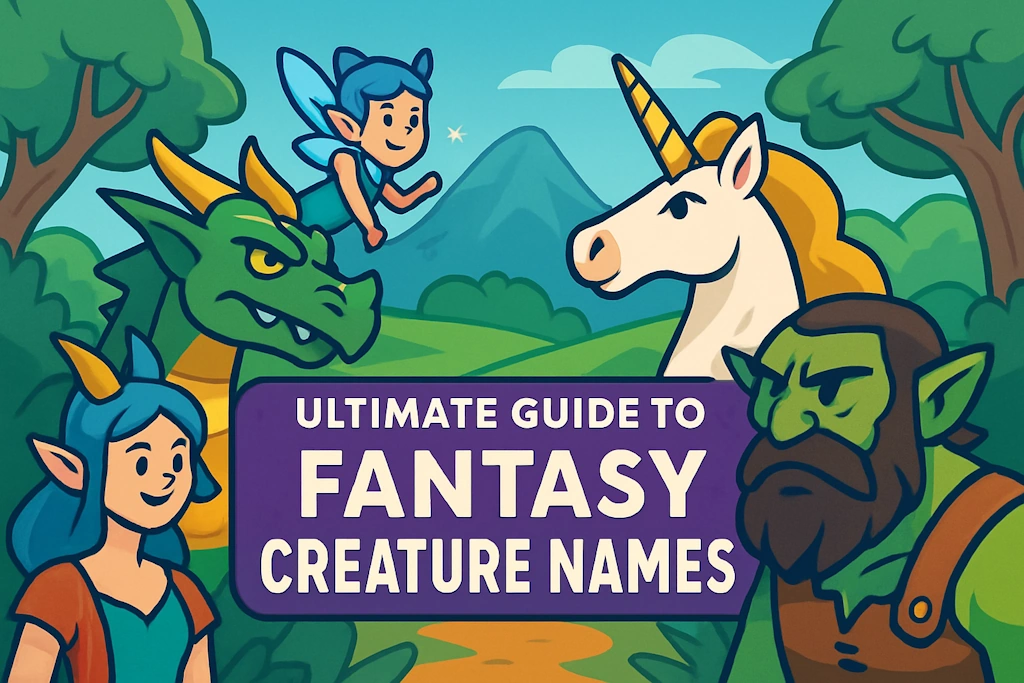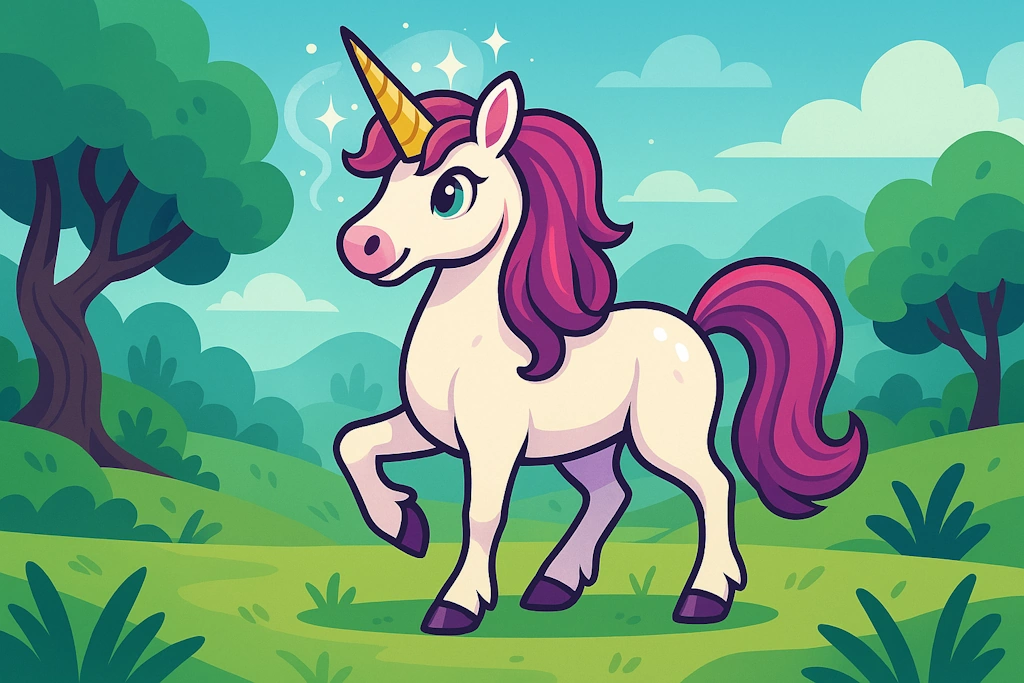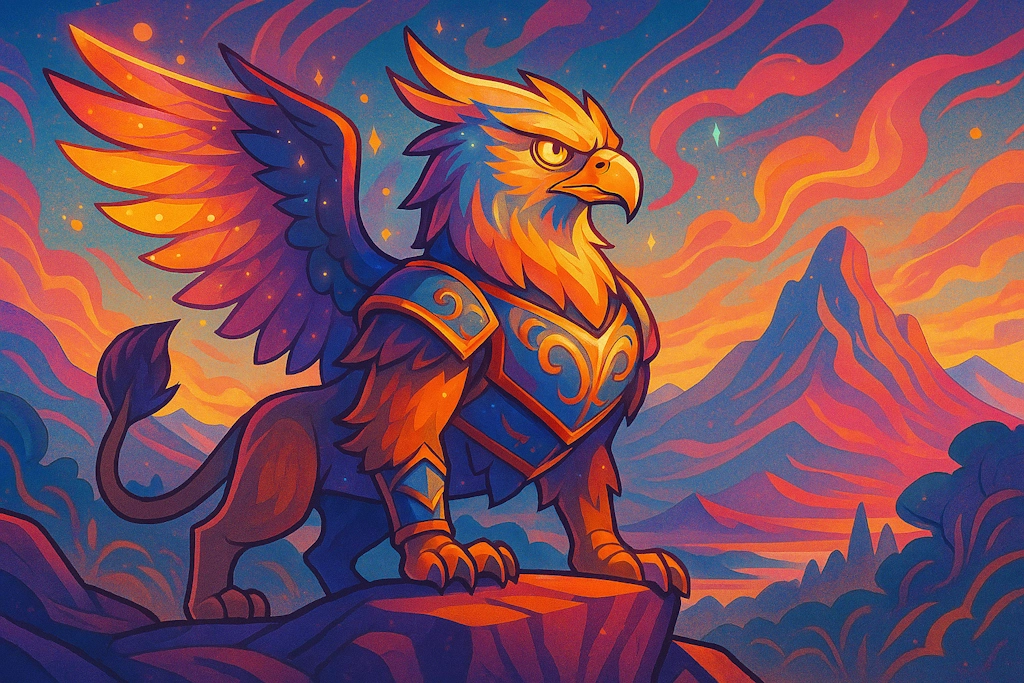Ultimate Guide to Fantasy Creature Names
Discover the art and science behind naming dragons, unicorns, griffins, and other mythical beings for your fantasy world

A comprehensive guide to naming conventions for fantasy creatures in your stories, games, and creative projects.
Introduction: The Power of a Name
In the realm of fantasy, a name is more than a mere label—it's the foundation of character identity, cultural heritage, and magical essence. Whether you're crafting a narrative for a novel, designing characters for a game, or building a fantasy world, the names you choose for your creatures can evoke powerful imagery, hint at hidden qualities, and enhance the richness of your world-building.
This comprehensive guide explores the art and science of naming fantasy creatures across various mythologies and traditions. From the ancient, fire-breathing dragons to the ethereal, horn-crowned unicorns, we'll examine naming patterns, cultural influences, and practical techniques to help you create authentic, memorable names for your fantasy beings.
Universal Principles of Fantasy Creature Naming
Before diving into specific creature types, let's explore some universal principles that apply across fantasy naming conventions:
Sound Symbolism
The sounds within a name can evoke specific qualities:
- Harsh consonants (k, t, d, g) - Suggest power, strength, and aggression (Drakhor, Gornath)
- Sibilants (s, sh, z) - Imply mystery, magic, or sinister qualities (Syrath, Zephyros)
- Liquid consonants (l, r) - Convey grace, fluidity, and elegance (Lunabreeze, Ariandel)
- Vowel sounds - Open vowels suggest grandeur (Aerin, Orion), while close vowels imply intimacy or secrecy (Mystiwind, Illyria)
Name Structure
Fantasy creature names often follow specific structural patterns:
- Compound names - Combining two words to create meaning (Stormwing, Dawnwhisper)
- Name + epithet - A core name followed by a descriptive title (Vazrakor the Eternal, Aurora the Mystical)
- Phonetic alteration - Taking familiar names and altering them with fantasy elements (Elizabeth → Elysabeth)
- Cultural adaptation - Borrowing from real-world naming conventions but with fantasy twists
Meaning and Etymology
Effective fantasy names often carry meaningful etymological roots:
- Ancient languages - Drawing from Latin, Greek, Norse, or Celtic roots
- Natural elements - Incorporating words for fire, water, earth, air, etc.
- Personality traits - Reflecting character qualities like courage, wisdom, or cunning
- Physical attributes - Referencing distinctive features of the creature
Pro Tip: Consistency Within Species
When naming multiple creatures of the same species, maintain phonetic and structural consistency to suggest shared cultural heritage. Dragons from the same region might all have names with similar sounds or structures, while unicorns from different magical realms could have distinctive naming patterns.
Dragon Names: Ancient Power and Elemental Majesty

Learn how to craft powerful and evocative dragon names for your fantasy world.
Dragons stand as perhaps the most iconic fantasy creatures, appearing in mythologies worldwide from European medieval legends to East Asian spiritual traditions. Their names often reflect their ancient power, elemental affinities, and imposing presence.
Dragon Naming Patterns
Dragon names typically follow these distinctive conventions:
- Harsh consonants - Names often incorporate hard, powerful sounds: Vazrakor, Khalaxar, Drakonis
- Multiple syllables - Usually 2-3 syllables for the primary name: Sy-rath, Ba-ha-mut
- Descriptive epithets - Titles that describe powers or achievements: "the Eternal," "Flamebringer," "Stormwing"
- Elemental associations - References to their elemental nature: Frostbringer, Emberwing, Stormfang
Common Name Elements
Dragon names frequently incorporate these elements:
- Elemental terms: -flame, -frost, -storm, -shadow
- Physical features: -wing, -claw, -fang, -scale
- Cosmic elements: -star, -void, -dawn, -dusk
- Power concepts: -doom, -fury, -might, -wrath
Famous Dragon Names
These legendary dragons from mythology and literature showcase classic naming patterns:
- Fafnir - The Norse dragon who hoarded cursed gold
- Smaug - Tolkien's "magnificent" dragon antagonist
- Bahamut - The great dragon king from Arabian mythology
- Tiamat - The ancient Mesopotamian dragon goddess of chaos
- Ryujin - The dragon god of the sea in Japanese mythology
Create Your Own Dragon Name
Looking for inspiration for your fantasy dragon character? Try our specialized dragon name generators:
Unicorn Names: Celestial Grace and Mystical Purity

Discover elegant and mystical naming conventions for unicorns in fantasy.
Unicorns embody purity, magic, and celestial connection. Their names reflect their ethereal nature, often incorporating elements of light, stars, and mystical properties. Unlike the harsh, powerful dragon names, unicorn names tend to be melodious and elegant.
Unicorn Naming Patterns
Unicorn names typically follow these patterns:
- Liquid consonants - Flowing sounds create names with grace and beauty: Luna, Astra, Celeste
- Light, airy vowels - Open vowel sounds suggest ethereal qualities: Aurora, Aella, Nova
- Descriptive epithets - Titles that emphasize magical properties: "the Radiant," "the Mystical," "the Luminous"
- Compound nature-magic elements - Combining natural elements with magical qualities: Moonbeam, Starwhisper, Dawnlight
Common Name Elements
Unicorn names frequently incorporate:
- Celestial elements: Star-, Moon-, Sun-, Aurora-
- Light properties: -gleam, -glow, -shimmer, -radiance
- Magical qualities: -mystic, -enchant-, -dream-, -spell-
- Pure elements: Crystal-, Silver-, Diamond-, -pearl
Cultural Influences
Throughout history, unicorns have appeared in various cultures with different names:
- Monoceros - Early Greek "single-horn" unicorn
- Kirin/Qilin - The Japanese/Chinese unicorn-like creature
- Shadhavar - The Persian musical-horned unicorn
- Lady Amalthea - The unicorn protagonist from "The Last Unicorn"
- Jewel - C.S. Lewis's talking unicorn from Narnia
Create Your Own Unicorn Name
Need a beautiful, magical name for your unicorn character? Try our unicorn name generators:
Looking for more unicorn inspiration? Explore our top 220+ unicorn names list.
Griffin Names: Noble Hybrids of Earth and Sky

Learn how to create majestic and powerful griffin names combining avian and feline elements.
Griffins (or gryphons) combine the regality of lions with the freedom and vision of eagles. As hybrid creatures, their names often reflect this dual nature, incorporating elements from both earthly and celestial realms.
Griffin Naming Patterns
Griffin names typically showcase:
- Classical influences - Drawing heavily from Greek and Roman mythology: Hyperion, Perseus, Apollo
- Avian elements - References to flight, feathers, and the sky: Skywing, Talon, Feather
- Feline qualities - Incorporating lion-like grace and power: Claw, Pride, Golden
- Compound structures - Combining avian and terrestrial aspects: Goldwing, Talonclaw, Skyroar
Etymology and Historical Origins
Griffin names draw from multiple ancient traditions:
- Ancient Greek - The term "grýphōn" (γρύφων) gave rise to names like "Gryphos" and "Gryphus"
- Persian - Known as "Shirdal" (lion-eagle) or "Homa," contributing regal names
- Egyptian - Associated with solar deities, inspiring sun-related naming elements
- Medieval European - Heraldic traditions that emphasized nobility and vigilance
Name Elements and Combinations
Effective griffin names often combine:
- Sky elements: Storm-, Wind-, Cloud-, Sky-
- Bird features: -wing, -beak, -talon, -feather
- Lion attributes: -mane, -claw, -pride, -roar
- Noble qualities: -noble, -royal, -guard, -watch
Create Your Own Griffin Name
Looking for the perfect name for your griffin character? Try our griffin name generators:
Other Fantasy Creatures: Diverse Naming Approaches
The fantasy realm is rich with diverse creatures beyond the iconic dragons, unicorns, and griffins. Each species carries its own naming conventions reflecting their nature, culture, and role in the fantasy ecosystem.
Goblins and Trolls: Harsh Pragmatism
Goblin and troll names typically feature:
- Guttural sounds - Harsh consonants reflecting rugged nature: Grog, Krak, Urk
- Short, practical names - Often single syllable or compound names: Bogkrat, Fradkrat
- Descriptive surnames - Based on appearance or deeds: Flatnose, Bonecrusher
- Onomatopoeic elements - Names that sound like their actions or traits: Grumble, Snaggle
Werewolves: Dual Identity
Werewolf naming reflects their dual nature:
- Human name + lupine title - Reflecting their dual identity: Gareth Moonstalker
- Nature-connected elements - Ties to the wild world: Forest-, Shadow-, -howl
- Lunar references - Reflecting their connection to the moon: Moon-, Silver-, Night-
- Pack relations - Terms denoting hierarchy or family: Alpha-, Elder-, Pack-
Fantasy Environments: Locations for Mythical Creatures
The worlds inhabited by fantasy creatures also feature distinctive naming patterns:
- Mountains - Often named for elemental or divine attributes: The Eternal Peak, Dragon Spire
- Forests - Emphasizing ancient magic and mystery: The Whispering Woods, Ancient Verdant Realm
- Lakes - Reflecting magical properties: The Crystal Waters, Moonlit Mere
- Islands - Suggesting isolation and wonder: The Mystic Isle, Enchanted Pearl Haven
- Volcanoes - Combining fire imagery with power: The Molten Throne, Dragon's Maw
Practical Naming Techniques
When creating your own fantasy creature names, consider these practical approaches:
Language Construction
For species with distinct cultures, consider creating a simple naming language:
- Define phonetics - Determine which sounds are common in their language
- Create root words - Develop a small vocabulary of terms important to their culture
- Establish patterns - Define how names are structured (prefixes, suffixes, compounds)
- Maintain consistency - Ensure names from the same species follow similar patterns
Cultural Adaptation
Borrow from real-world cultures but with fantasy twists:
- Norse influence - For creatures of ice, mountains, or warrior cultures
- Celtic patterns - For fey creatures, nature spirits, or ancient woodland beings
- Arabic/Persian styles - For desert creatures or beings associated with ancient wisdom
- East Asian influences - For creatures with connections to balance, spiritual power, or transformation
Meaning-Focused Approach
Create names based on significant attributes:
- Physical features - Names based on distinctive physical traits
- Behavioral traits - Names reflecting how the creature acts or moves
- Magical abilities - Names highlighting special powers or magical affinity
- Historical significance - Names referencing important events or ancestry
Pro Tip: Testing Names
Before finalizing your fantasy creature name, test it in different contexts:
- Say it aloud to ensure it's pronounceable
- Consider how it looks written in your world's different scripts
- Check that it doesn't have unintended meanings or associations
- Confirm it fits the overall tone and aesthetic of your fantasy world
Conclusion: The Living Art of Fantasy Naming
Naming fantasy creatures is both an art and a science—a delicate balance of linguistic creativity, cultural resonance, and practical functionality. The most memorable names not only sound appealing but also enhance characterization, worldbuilding, and narrative immersion.
Whether you're creating a fearsome dragon, a graceful unicorn, a noble griffin, or any other mythical being, the principles and techniques in this guide provide a foundation for developing authentic, evocative names that bring your fantasy creatures to life.
Remember that fantasy naming traditions continue to evolve. While honoring established conventions, don't hesitate to innovate and develop unique naming patterns that make your fantasy world distinctive and memorable.
Create Your Own Fantasy Names
Need help creating fantasy creature names for your stories, games, or creative projects? Try our full range of fantasy name generators:
For more in-depth creature guides, explore our detailed articles on dwarf names, troll names, mermaid names, centaur names, and angel names.